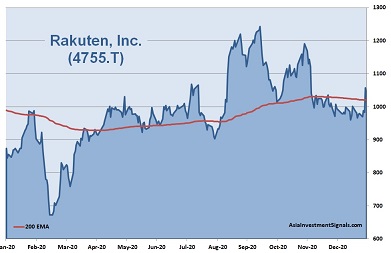 Rakuten, Inc. (4755.T) is the sixth-largest e-commerce company in the world and is often referred to as ‘the Amazon of Japan.’ Besides e-commerce, the company has built up a comprehensive ecosystem that includes travel, advertising, membership cards, sport and event management, bank, securities trading, insurances, communication and messaging services, TV, digital content, and many more services. Rakuten runs a sophisticated loyalty program that encourages customers to cross-use all services in this ecosystem.[mepr-active membership=”1734″ ifallowed=”show” unauth=”message” unauth_message=”Please login or purchase a membership to view full text.”] Last year, mobile service was launched in April with the target to become the fourth full mobile network operator in Japan. Mergers and acquisitions as well as strategic partnerships in the internet and e-finance businesses have further boosted the company’s growth. About 80 percent of Rakuten’s revenue is still generated in Japan, followed by the Americas with 16 percent. Some unprofitable overseas businesses have been scaled back lately.
Rakuten, Inc. (4755.T) is the sixth-largest e-commerce company in the world and is often referred to as ‘the Amazon of Japan.’ Besides e-commerce, the company has built up a comprehensive ecosystem that includes travel, advertising, membership cards, sport and event management, bank, securities trading, insurances, communication and messaging services, TV, digital content, and many more services. Rakuten runs a sophisticated loyalty program that encourages customers to cross-use all services in this ecosystem.[mepr-active membership=”1734″ ifallowed=”show” unauth=”message” unauth_message=”Please login or purchase a membership to view full text.”] Last year, mobile service was launched in April with the target to become the fourth full mobile network operator in Japan. Mergers and acquisitions as well as strategic partnerships in the internet and e-finance businesses have further boosted the company’s growth. About 80 percent of Rakuten’s revenue is still generated in Japan, followed by the Americas with 16 percent. Some unprofitable overseas businesses have been scaled back lately.
Rakuten’s internet services business contributed 52 percent to the total revenues and grew by 8 percent over the first nine months of 2020. However, this segment produced losses. The FinTech segment contributed 37 percent to the revenues and grew by 20 percent over the same period. It is currently the only profitable segment in the company. The newly launched mobile segment contributed already 11 percent to the revenues and grew by 54 percent. However, this segment is also responsible for significant losses in the company.
Rakuten was founded in 1997 and is headquartered in Tokyo, Japan. The company is listed on Tokyo’s stock exchange since 2000. Its shares can also be traded in Germany and the US. Major shareholder is the founder and CEO, Mr. Hiroshi Mikitani, and his wife, with ownership of together about 37 percent. 56 percent of the shares are in public hands.
With over 20 thousand employees, Rakuten reported revenues of 1.04tn JPY (9.9bn USD) and a pre-tax loss of 119.6bn JPY (1.1bn USD) over the first nine months of 2020. Revenues increased by 15 percent compared to the same period a year ago. For the full year 2019, revenues increased by 15 percent while profits were negative. The increase in revenue is mainly due to robust growth in the fintech segment, especially a growing card’s membership base as well as a growing banking and securities services business. Profits are down mostly due to investments in the new mobile service segment but were also affected by the pandemic’s impact on Rakuten’s travel and event services. The company’s operating margin are declining for five years already. Cash reserves increased by 74 percent to 2.6tn JPY (24.6bn USD), while bonds and debts increased by 24 percent to 2.1tn JPY (20.5bn USD) over the first nine months 2020.
Rakuten shows only a weak balance sheet with poor financial strength and profitability. The equity ratio is at only 6 percent, and the gearing, defined here as total liabilities to total equity, at a very high 1513 percent. The company keeps issuing new debt. JCR’s current credit rating of Rakuten is BBB+ with a negative outlook. Next earning results will be announced around February 12th.
Rakuten’s shares are trading in a sideward range between 700 and 1,400 JPY since 2016 already. Lows have been retested during the corona crash last year in March. Shares increased by 4 percent this year. The company is currently priced at 2.1 times book value and at 1.3 times operating cash flow. The latest dividend yielded about 0.44 percent. 10 out of 17 analysts have a ‘buy’ or ‘outperform’ recommendations on the stock.
Our conclusion: Despite the weak financial positions, Rakuten could return to profitability soon once the mobile business’s initial investment is completed. The valuation of the company is reasonable and comes with a 20 percent annual growth rate in revenues. Most of Rakuten’s business segments have a positive outlook over the next years. The company is well-positioned in a strong competitive environment. Assuming a stable global economy, we expect the share price to increase 15 to 20 percent this year.
AIS Rating: ★★★★☆
| 2015 | 2016 | 2017 | 2018 | 2019 | 2020 Q1-3 Only |
|
|---|---|---|---|---|---|---|
| EPS (JPY) | 33.3 | 26.7 | 79.3 | 104.4 | (23.6) | (52.6) |
| Change (%) | (20) | 196 | 32 | (123) | (404) | |
| DPS (JPY) | 4.5 | 4.5 | 4.5 | 4.5 | 4.5 |
| P/E | P/E INDUSTRY |
P/B | P/CF | Equity Ratio* (%) |
ROE (%) |
LIAB./ Equity** (%) |
Div YLD (%) |
|---|---|---|---|---|---|---|---|
| n/a | 23 | 2.1 | 1.3 | 6 | (12.6) | 1513 | 0.4 |
* Equity / Total Assets, ** Total Liabilities / Equity
[/mepr-active]
